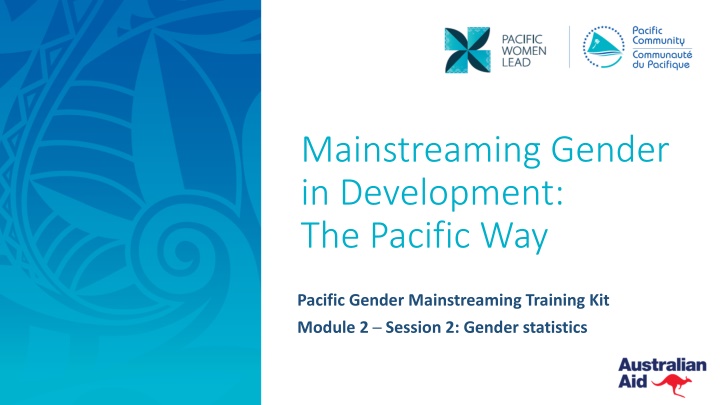
Gender Statistics and Data Analysis
Explore the importance of gender statistics, why sex-disaggregated data is essential, how to identify gender inequalities through data analysis, and the purpose of gender statistics in policymaking and advocacy efforts in development settings. Discover where to find sex-disaggregated data in national surveys for comprehensive analysis.
Download Presentation

Please find below an Image/Link to download the presentation.
The content on the website is provided AS IS for your information and personal use only. It may not be sold, licensed, or shared on other websites without obtaining consent from the author. If you encounter any issues during the download, it is possible that the publisher has removed the file from their server.
You are allowed to download the files provided on this website for personal or commercial use, subject to the condition that they are used lawfully. All files are the property of their respective owners.
The content on the website is provided AS IS for your information and personal use only. It may not be sold, licensed, or shared on other websites without obtaining consent from the author.
E N D
Presentation Transcript
Mainstreaming Gender in Development: The Pacific Way Pacific Gender Mainstreaming Training Kit Module 2 Session 2: Gender statistics
Learning outcomes Learning outcomes At the end of this session you will understand: what gender statistics are why it is important to produce and use sex-disaggregated data and gender statistics in their work.
Identifying the differences Identifying the differences In order to identify if there are gender inequalities, it is necessary to have data on the situation of women and men. Data on its own is of no value until there has been an analysis of the information. Gender analysis is a comparative approach.
Understanding the differences Understanding the differences 1. Data are collected and presented disaggregated by sex as a primary and overall classification. 2. Data reflect gender issues. 3. Data are based on concepts and definitions that adequately reflect the diversity of women and men, and capture all aspects of their lives. 4. Data collection methods take into account stereotypes, and social and cultural factors that may induce gender biases.
The purpose of gender statistics The purpose of gender statistics They help identify the issues and the need to design and deliver more comprehensive and gender responsive policies, programmes and services They help monitor changes and progress, including the effectiveness of programmes and services in response to the needs of women and men They help formulate indicators to monitor progress and report towards gender equality They help make women s and men s roles and contributions visible They support awareness raising and advocacy campaigns about gender inequality issues.
Where to find sex Where to find sex- -disaggregated data disaggregated data National surveys provide some sex-disaggregated data such as: the Census of population and housing which provides demographic, social and economic information about all members of the population and their housing the Household Income and Expenditure Survey (HIES) which provides economic, social and housing information that is used to analyse living conditions, poverty and hardship, consumption patterns and a range of socio-economic indicators from a nationally representative sample of households the Demographic and Health Survey (DHS) which provides information on demographic trends, fertility, health, nutrition and women s empowerment from a nationally representative sample of households.
Where to find gender statistics Where to find gender statistics Sources of Gender Statistics include, but are not limited to: Household labour force surveys Family health and safety surveys Business, banking and informal sector surveys Time-use surveys Administrative data from ministries and government departments Records and reports relating to compulsory social security/superannuation funds, welfare/beneficiary support, taxation, business licenses, financial institutions, and the annual reports of organisations, businesses and ministries.
Useful resources Useful resources Gender Statistics Training Curriculum Guide to gender statistics and their presentation. United Nations (2015) Gender Statistics manual UNECE Toolkit for training users in gender statistics Understanding Statistics website of the Australian Bureau of Statistics (ABS.
Evaluation questions Evaluation questions 1. What are gender statistics? 2. What is the purpose of gender statistics?
Evaluation questions Evaluation questions 1. What are gender statistics? a)Data on women b)Data on families c) Data disaggregated by sex and analysed to explain gender gaps d)Data disaggregated by sex
Evaluation questions Evaluation questions 2. What is the purpose of gender statistics? a)To provide information on women s issues b)To provide information on gender inequality to raise awareness c) To design programmes that will not undermine existing gender roles d)To formulate indicators to monitor progress around gender equality
